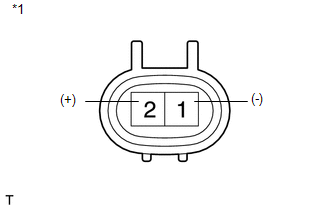Toyota Venza: On-vehicle Inspection
ON-VEHICLE INSPECTION
PROCEDURE
1. INSPECT COOLING FAN MOTOR
|
(a) Check that the motor operates smoothly when the battery is connected to the cooling fan motor connector. Text in Illustration
If the motor does not operate smoothly, replace the cooling fan motor. |
|
(b) Connect the pickup of a clamp-on ammeter over one of the 2 wires for the cooling fan motor.
(c) Measure the current while the motor is operating.
Standard Current:
|
Item |
Condition |
Specified Condition |
|---|---|---|
|
Cooling fan motor (w/o Towing package) |
20°C (68°F) |
11.8 to 14.8 A at 12 V |
|
Cooling fan motor (w/ Towing package) |
20°C (68°F) |
7.9 to 10.9 A at 12 V |
If the result is not as specified, replace the cooling fan motor.
2. INSPECT NO. 2 COOLING FAN MOTOR
|
(a) Check that the motor operates smoothly when the battery is connected to the No. 2 cooling fan motor connector. Text in Illustration
If the motor does not operate smoothly, replace the No. 2 cooling fan motor. |
|
(b) Connect the pickup of a clamp-on ammeter over one of the 2 wires for the No. 2 cooling fan motor.
(c) Measure the current while the motor is operating.
Standard Current:
|
Item |
Condition |
Specified Condition |
|---|---|---|
|
No. 2 cooling fan motor (w/o Towing package) |
20°C (68°F) |
7.9 to 10.9 A at 12 V |
|
No. 2 cooling fan motor (w/ Towing package) |
20°C (68°F) |
7.9 to 10.9 A at 12 V |
If the result is not as specified, replace the No. 2 cooling fan motor.
 Components
Components
COMPONENTS
ILLUSTRATION
...
 Removal
Removal
REMOVAL
PROCEDURE
1. REMOVE RADIATOR ASSEMBLY AND FAN ASSEMBLY WITH MOTOR
HINT:
See page
2. REMOVE FAN
(a) Remove the nut and fan.
3. ...
Other materials about Toyota Venza:
System Diagram
SYSTEM DIAGRAM
Communication Method
Transmitting ECU
Receiver
Signal
Communication Method
Main body ECU (Driver Side Junction Block Assembly)
Power back door ECU (Power back door motor ...
Pressure Control Solenoid "A" Electrical (Shift Solenoid Valve SL1) (P0748)
DESCRIPTION
Changing from 1st to 6th is performed by the TCM turning shift solenoid valves
SL1, SL2, SL3, SL4 and SL on and off. If an open or short circuit occurs in any
of the shift solenoid valves, the TCM controls the remaining normal shift solenoid
...
Problem Symptoms Table
PROBLEM SYMPTOMS TABLE
HINT:
Use the table below to help determine the cause of problem symptoms.
If multiple suspected areas are listed, the potential causes of the symptoms
are listed in order of probability in the "Suspected Area" ...
0.1599

